Because TriMet and the City of Portland won’t do more to prevent people from driving cars on 82nd Avenue in the future, a $320 million transit upgrade might not be enough to significantly improve bus service.
TriMet 82nd Avenue Transit Project will bring their high-capacity FX bus service to 10 miles of 82nd Avenue between Clackamas Town Center and northeast Portland. To speed up service on the busiest bus corridor in the state, they’ll consolidate stops, improve stations, make safer pedestrian connections, update signals, and more. But even with these investments, “It may be harder for buses to stay on schedule as traffic congestion grows in the future,” TriMet says.
That’s largely because project leaders feel they must maintain ample access for car drivers, instead of devoting more space to more efficient lanes for buses and bikes. Since bicycle access on 82nd has already been ruled out, and the political support does not appear to exist for reducing automobile access, TriMet is now exploring additional investments they say will be needed to keep buses moving.
TriMet released an online open house today that asks the public to weigh in on three options under consideration:
- Option One – “Some BAT Lanes”: Three miles of new transit-priority, a.k.a. “business access to transit” BAT lanes (see graphic below), in each direction.
- Option Two – “More BAT Lanes”: Seven miles of BAT lanes in each direction.
- Option Three – Intersection Widening: Widening 82nd Ave at three intersections — Powell, Holgate, and Foster — to make room for more transit lanes. (Note that the widening is being considered because they aren’t willing to reduce driving lanes beyond what’s already proposed.)
TriMet hasn’t revealed pricing for each option, but Option One would be the cheapest. Option Two, More BAT Lanes, would be at least twice the cost of Option One. And the intersection widening proposal would cost four times as much as Option One.
TriMet says these new options “could exceed project funding” and will require more study and analysis before moving forward.
Take the short survey online and/or visit an in-person open house scheduled for Wednesday, April 23rd from 4-6:30 pm at PCC Southeast.


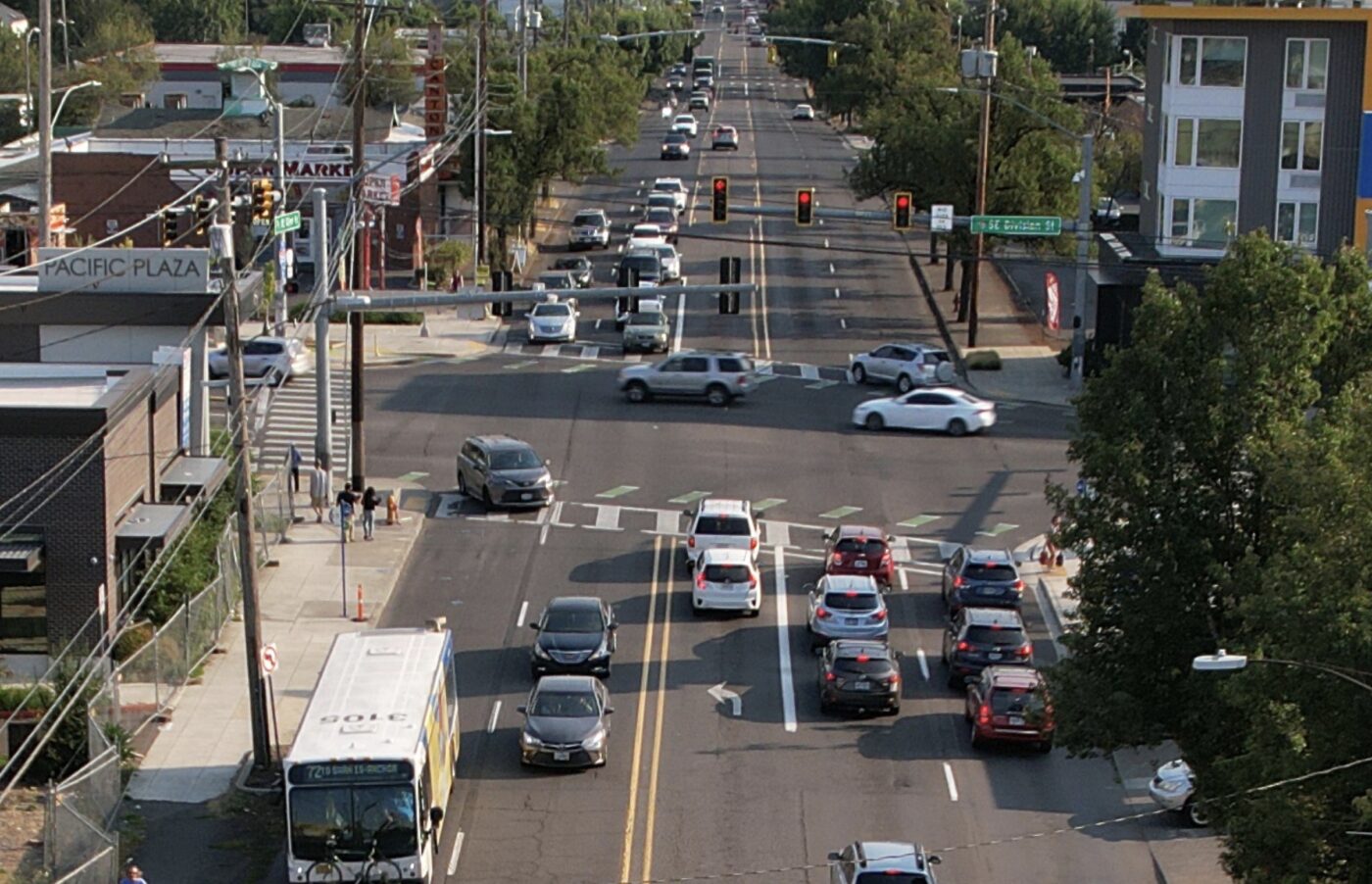
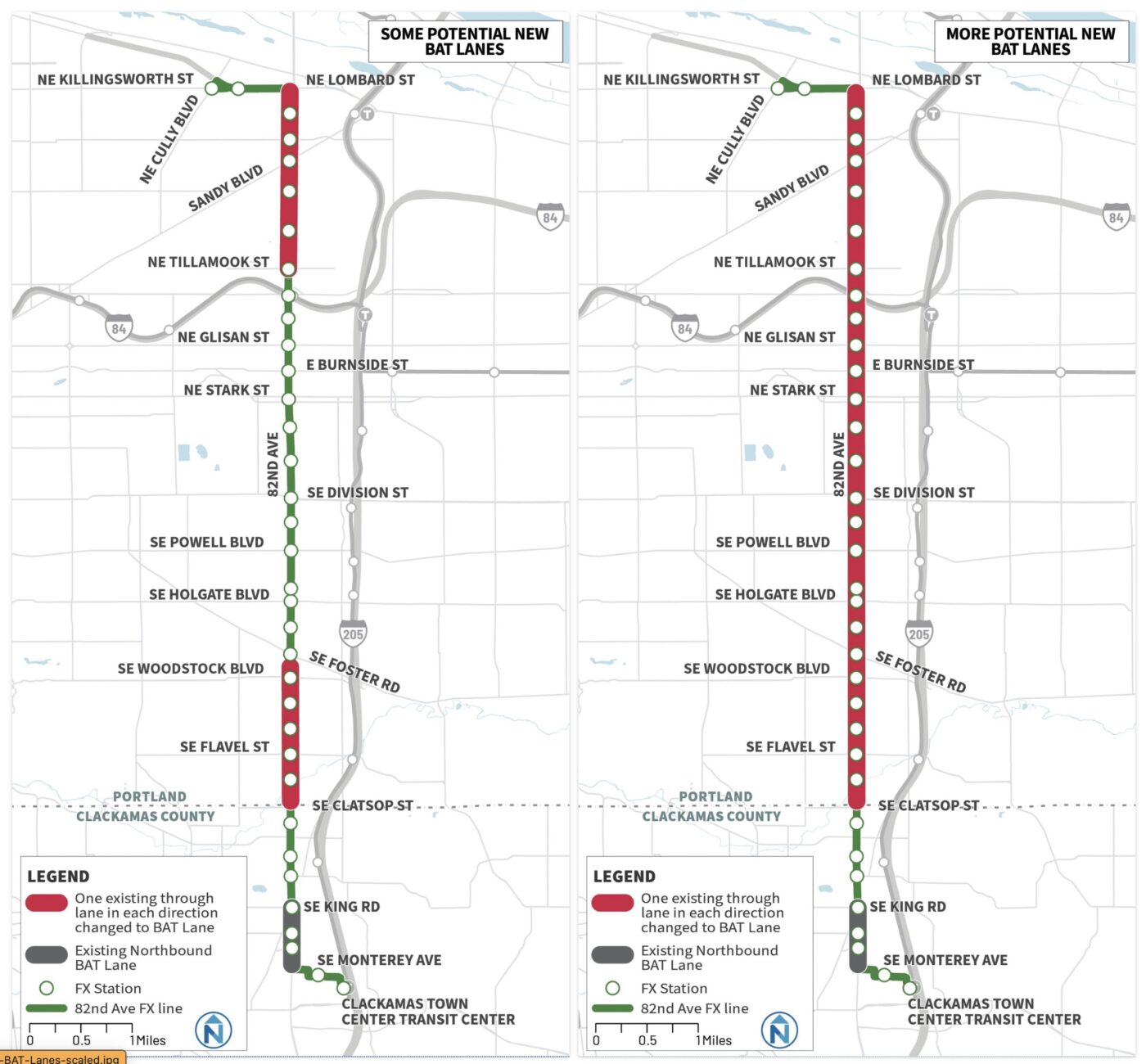
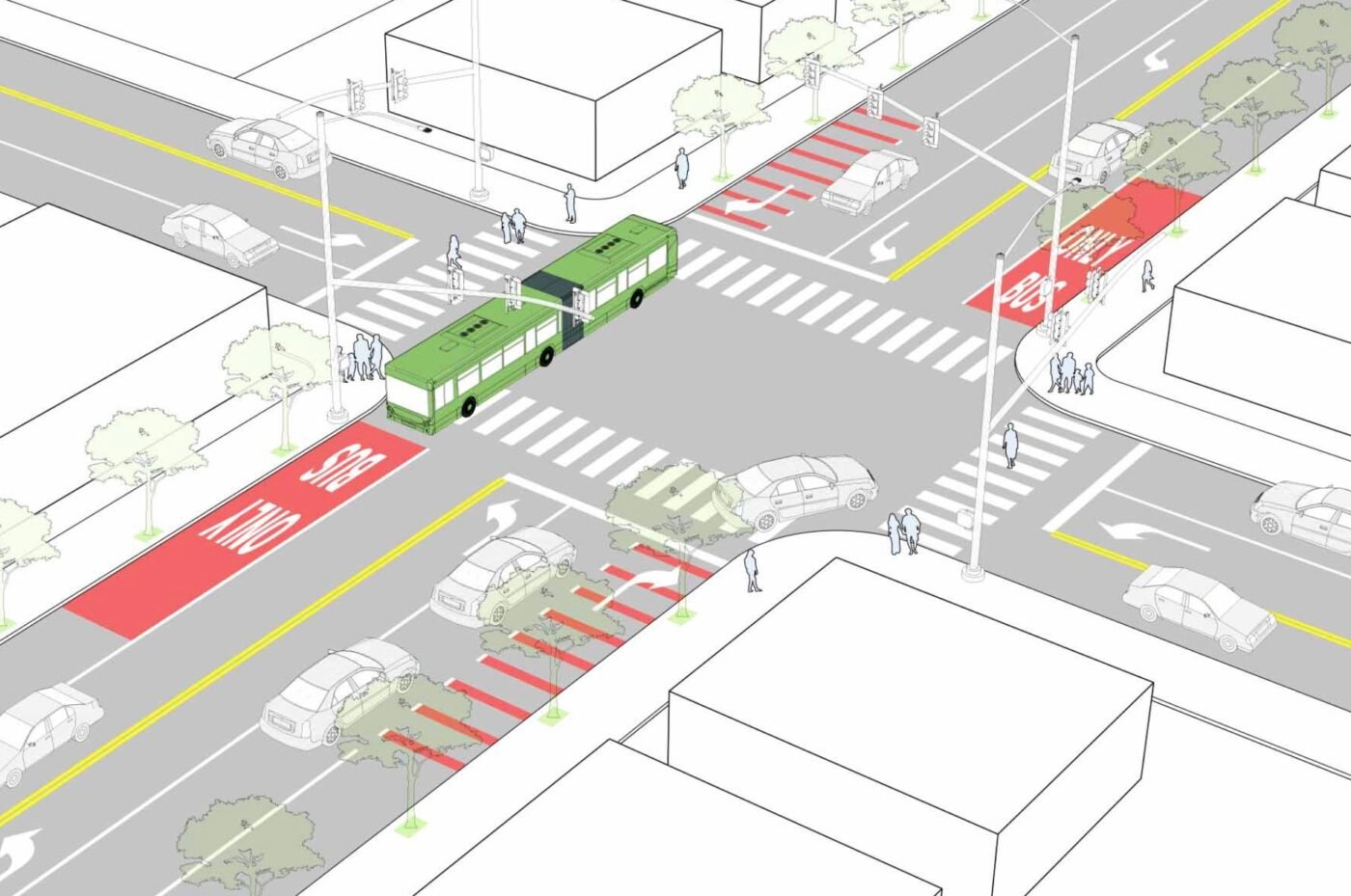
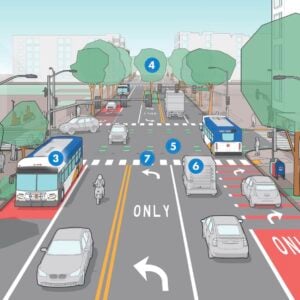
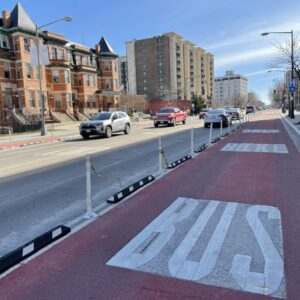

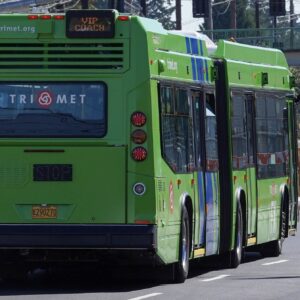
Thanks for reading.
BikePortland has served this community with independent community journalism since 2005. We rely on subscriptions from readers like you to survive. Your financial support is vital in keeping this valuable resource alive and well.
Please subscribe today to strengthen and expand our work.
Can someone explain to me the cost of these bus lanes? It seems like the difference between the options is how the roads are painted. Presumably 82nd will be painted in any scenario, but the trimet website makes it seem like painting bus lanes will make the project significantly more expensive. I’m sure the budget is already a gazillion dollars for what seems to normal folks like pretty modest improvements. Please help me understand how these budget numbers arise. I feel like I have this question for everything our local governments do — I generally support it, but I am absolutely dumbfounded by the magnitudes of the costs.
I suspect the driven by decisions to include extra-fancy signal along with the paint. These likely have some sort of communication with the buses, and the project may be paying for that hardware, too. Other than the signal which could be $100K or more upgrade per signal and some additional signs $10K-25K/ea installed, it is hrd to imagine that the BAT lanes would be that large of an upcharge.
If TriMet is planning on not having signal priority for areas without bus lanes, that’s news to me (and a huge issue).
I think that the survey is poorly worded – it must be twice the cost of the additional cost of the “Some BAT Lanes” scenarios
That is correct. The addition cost of “more BAT” cost is double the additional of “some BAT”. Not double the cost of the whole project.
Street widening usually requires the buying of more right-of-way (a very expensive process particularly if a building has to be demolished) and moving the sewer lines and building new curbs (also super expensive), and often but not always moving water and utility lines.
Some possibilities: new signals are expensive, they’re talking about new shelters in different places, with new concrete pads for the long buses, and some new lanes will be put in which means moving curbs AND storm sewers. I can’t remember but maybe there are median changes with curbs and landscaping. Lots of paint. Utility work while things are torn up. Traffic control!
Design and overhead is probably ten percent plus, they’ve got a lot of work in on this already.
I’m not entirely sure, but I think it’s a misleading survey. I would interpret it as “twice the cost of the additional aspects of the Some BAT lanes”. Not having even a relative magnitude of this cost is really frustrating, and the ambiguity of the wording doesn’t help.
Given that purchasing ~3 properties is 4x the cost of the Some BAT lanes, I’d ballpark that it $1M. Maybe a $1M/$2M/$4M split? I feel like they really needed to be more clear about this!
I certainly found it confusing. My suspicion is that, as nate suggests below, they are angling for “Some BAT” as the preferred alternative and using surveys like this one to explain why the final product will be underwhelming. I guess I’m glad they are managing the PR, but the tone of the survey feels condescending.
Wouldn’t surprise me, but that would be a crying shame.
TriMet should be loudly advocating for the options which reduce their operational costs. More bus lanes = more predictable schedule = fewer drivers and vehicles needed to maintain acceptable headways, especially at peak times when labor is most expensive. Maybe this means more auto delay, but I strongly believe that if TriMet is not advocating for better transit, then no public agency will. They are the service provider and need to set the tone!
Micah, it’s my understanding that much of the added cost is mitigating the impacts of diversion onto other routes.
Example: if it’s full BAT lanes then there will be more automobile congestion which will lead people to choose other routes, including into neighborhoods. They will invest money on those neighborhood streets—speed bumps, modal filters, etc—which adds cost.
I had not considered this possibility.
Thanks for the thoughtful and informative replies!
Submitted mine.
What I want to know is why does the first 72 of the morning arrive at CTC *after* several buses that originate at CTC have just left?
Do they really believe that CTC is the destination rather than people coming down 82nd possibly proceeding on somewhere?
Just another example of how little consideration TriMet gives to people who’s origin and destination aren’t on a single transit line.
TriMet has some really frustrating anti-rider transfers, but man that’s a brutal one
Option 1: The same half-assed ideas we always get from Trimet/PBOT. Marginal but largely ineffective “improvements” unwilling to commit to meaningfully improving transit or pedestrian experiences. Wastes a bunch of money performatively while accomplishing nothing (but probably still pissing off drivers, anyway). I fully expect this “solution” to win the day.
Option 2: Faster transit, safer pedestrian experience, AND could divert up to 25% of car traffic to I-205 (where it should be anyway)?!?! The only one of the three options that makes any sense at all.
Option 3: Tons of money to make pedestrians less safe and not meaningfully improve transit times? What is this option even doing on the table other than draw attention to how inane it is?
Unfortunately, I think we all know how this is likely to go. Option 2 gets labeled the “woke” solution. Option 3 is the “car-head” solution. So we end up with the nice “middle of the road, common sense” solution, Option 1. In reality, 1 should be the car-head option, 2 should be the sensible compromise, and 3 (the woke option) should pair down to two car lanes with true BRT down the middle. Then we could have an actual compromise that still means something. Instead, they built the options with an entirely non-credible pro-car scenario that shouldn’t even be considered, just so they can rule out “the extremes” and build the half-assed thing they want to anyway.
This is the COTW. So spot on.
Please dont let them do to 82nd what they did to the eastern section of Division Street. What a nightmare that street is.
I thought they were reducing driving lanes from two through-lanes to one.
yes they are. I added, “beyond what’s already proposed” to that line just now to help clarify.
Maybe pedestrians should be the indicator species on 82nd Avenue.
“To speed up service…they’ll consolidate stops, improve stations, make safer pedestrian connections, update signals, and more.”
Consolidating stops will mean that pedestrians will have to travel further on a loud and busy street and cross at least two more intersections on each trip, out and back. If we add turn lanes to speed car throughput that means big intersections are even wider and will have more conflicts for people walking.
Here are some possible actions:
–Abolish left turns, left turn lanes, and left turn light cycles. Make a new pattern of passing your street and taking three rights. Turning movements will take place at slower speeds and pedestrians will have less to look out for.
–Make intersection curb lanes Transit and Right Turn on Signal only, with a priority leading signal Any Time a bus is present, until the bus is clear. This will keep the buses moving and help pedestrians since every green signal will give people walking a no conflict walk signal in one direction (cars can only go straight unless there is a right turn arrow).
–To keep pedestrians safe, have a drop arm on the right turn lane when there is no turn signal.
–Put raised crosswalks across driveway entrances with a rumble strip and beacon to alert drivers that pedestrians have priority.
–Pick up bus passengers at every corner so they don’t have to run after the bus.
Drivers would only answer the deboarding signal at shelters. Put up a signal light for passengers to flag the bus on a corner without a shelter.
I haven’t modeled this but I think it could actually improve car throughput. Business access is an issue and some design work in the parking zone would probably be necessary. There’s at least potential for better outcomes for car users and business owners.
Option 2 is the best chance to convert the road from an auto-centric obsolete highway to an urban-oriented main city road. By reducing the cars to one lane each way, it cuts noise and pollution, and makes street-crossing easier for pedestrians. It improves bus transit time and reliability. Even better if bicycles are permitted on the BAT lanes.
Theoretically, except the “more BAT lanes” option (2) seems a bit misleading since the BAT lanes will exist immediately after intersections, and likely only for a short distance. It’s unlikely they are in any way continuous. Also, keep in mind most major intersections (e.g., 82nd and Powell) are already 6 lanes wide. If they widen the road at other intersections that’ll carry through much of the time, negating any potential road diet effects.
I made the mistake of supporting the 3rd option on the site because the other two were so bad, but really there is no good option. Expanding the ROW to add another SOV lane with the pretense of “making room for transit” is kind of like saying let’s expand I-5 so we can have a small building on top, bike lanes on broadway and a flyover bike bridge. It’s entirely unnecessary.
This is surprisingly not the case for 82nd. While the major cross-streets tend to have right turn lane cut outs, 82nd does not – except for the slip lane from 82nd SB to Foster WB.
I guess you’re right! Thanks for the correction. Maybe there is some hope for this place. I always forget how much I avoid this road.
And the north side of 82nd at Holgate where there are bus pullouts. This is, roughly, what they are proposing on Option 3
I find this snippet fascinating:
I didn’t like my choices so I picked the worst one? You obviously have sophisticated and well-developed views on stuff like this, so it’s striking to me that you did not automatically and unequivocally choose the woke alternative over the car-head and ‘common sense’ alternatives (in nate’s terms).
I think people that are into transportation activism and urban design on one hand and those of us that are less engaged in such discussions on the other bring very different expectations to a questionnaire such as this one. I assume the purpose of this questionnaire is to gauge public sentiment around the priorities for the 82nd rehab, while I’m guessing you and blumdrew see it as a way to express preferences about design specifics. The two are related, but differ fundamentally: one is subjective and based on values, while the other is objective and can usefully benefit from expertise and information.
The 82nd rehab project will likely fail miserably by both measures (i.e., it will deliver a substantially more car oriented road than optimal that will also not function as its designers envisioned due to poor design and execution). But, as transportation activists, I think it’s useful to separate the two dynamics. In particular it’s worth acknowledging that convincing stakeholders that less car dependence == better life is a political project that deserves as much attention and effort as specific project design.
Yeah Micah no excuses here. Thanks for the perspective. Really interesting take. If the purpose of the survey was to gauge modal priorities, it was confusing enough to be fairly ineffective at doing so. If it’s there for design specifics, again, the survey was vague enough to make even this objective suspect.
Honestly, I am so disillusioned by the choices offered, I’m still not sure which is best. As much as i dislike 82nd, it’s one of those streets that are close to my heart (which is a weird thing to admit). In a backward sort of way my hope was that if we were ever to recognize the worth of building true BRT and separated bike lanes on 82nd (what I feel like a worthwhile project would be), we’ll need more space. Are any changes a step in the right direction? Maybe. Was option 3 a good choice? I have no clue.
No need to feel weird about repping 82nd! It’s close to a lot of hearts. I also wish for a transformative project to create a high-quality multimodal transportation corridor on 82nd. That it would be worth building is self-evident. We won’t get anything great, but I still hope the 72 bus line can be significantly improved and that the street can be made more humane for pedestrians.
Room for fewer cars on 82nd will bring a lot more traffic, especially during commute times, to the nearby residential streets. Widening at Foster, Holgate and Powell will likely bring more traffic to 82nd and more traffic to nearby residential streets.
Am I the only one that thinks 82nd Ave is a lost cause? It’s a “stroad” flanked by parking lots, strip malls, and big-box stores; like a pig and we’re discussing how much to budget for lipstick. Improvements can be made, and should be made, but don’t expect transformation.
Wow that’s a really messed up way to look at it. People live and work and walk and bike and exist on that street. They deserve to exist on a humane street that is welcoming and safe and healthy don’t they?
Absolutely! I live two blocks west of 82nd, it never occurs to me to go east for walks, I stay away from the street like it’s the plague. If you think of the folks that fall under the bell curve as the ones contributing to a healthy functioning city, well then, the folks you see walking along 82nd are the outliers of that bell curve. It’s sad but kind of the reality. You have to spend a lot of time around 82nd to truly know what the livability is like. Maybe better transit will fix it, but there’s a whole systemic system fueling poverty around 82nd that is beyond one’s comprehension unless you’re out here on the daily.
Not a lost cause, but Option 1 and 3 wouldn’t result in transformation at least in the area I live near. I think that option 2 would be transformative (but not perfect). I live 3 blocks off 82nd and I avoid walking along it as much as possible. It’s a scary street to be next to for any length of time. If there were a bus lane between me and most car traffic, that would be transformative and add a whole new cohort of customers to the businesses there. There are many businesses that have limited parking and by increasing safe pedestrian access they could increase business considerably. Good examples of that would be the little mall of restaurants at SE Harrison, Panderia Super Market 5 de Mayo and their food truck, and the food cart pod at NE Davis. I could see more auto-dependent businesses converting to those and similar types of uses pretty successfully.
As someone who lives just off it and uses it almost every day I don’t think it’s a lost cause. The changes they’ve already made have noticeably improved it. It’s flanked by parking lots, strip malls and big box stores because it’s a stroad. You won’t get pedestrian friend development until it’s changed. No one is claiming it’ll change overnight or even in a decade but if you want it to change you have to take a first step.
I don’t think it’s a lost cause either, if the transit upgrades come with all the pedestrian friendly infrastructure it promises, then it’ll definitely be heading in the right direction.
The next step should be enforcement:
-no camping along the side streets of 82nd.
-arrest chronic drug offenders smoking fentanyl in the open.
-displace the sex worker industry.
-curtail the chronic vandalism and graffiti.
-consistent trash clean up.
-making sure bus stops aren’t used as homeless shelters.
-regular police patrols up and down 82nd.
-investigate corrupt business enterprises (car dealerships selling high interest loans to customers with bad credit).
It took me 3 reads to figure out what does stands for (“business access to transit” doesn’t appear until after BAT has been used) … and “business access to transit” is not a self-explanatory term. Wouldn’t mind a sentence explaining what it means. Thanks!
I hope increasing transit along 82nd will draw users. As of now it’s not very comfortable taking the bus along 82nd, maybe I’m being classist, but it seems like everyone riding is either poor or unhealthy. It’s hard to imagine attracting a cross section of Portland with disposable incomes wanting to patron nearby businesses. Outside of downtown, transit seems like nothing more than a subsidized system to move the poor around in a way that doesn’t really improve their lives. It’s nice being able to take the bus to work, but is it really that nice when it takes over an hour one way. I don’t think so…